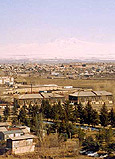|
UNDER
CONSTRUCTION
|
E
of Azatan is Arevik,
with 19th
c. church. |
|
The
city of
Gyumri
(the administrative center of the Marz, briefly Kumayri,
before than Leninakan, before that Alexandropol) is conspicuous
for the large cemeteries, some full of the victims of the 1988
earthquake. Despite many
well-intentioned efforts, the economy of the
city remains a shambles ten years
after the event, with thousands of people
still living in “domiks,” |

|
|
|
|
converted cargo containers, while newly rebuilt apartments stand
empty.
There is still a substantial international presence from
various assistance projects. In
1926, League of Nations High Commissioner for Refugees Fridtjof
Nansen, accompanied by his secretary, fellow Norwegian Vidkun
Quisling of later dark repute, visited Gyumri and its huge
complex of schools and orphanages sheltering 11,000 Armenian
orphans under the auspices of the American Near East Relief.
The
main square has a pair of
churches, one standing, one a
distinguished ruin awaiting reconstruction. There is a reputable
European-style hotel, a well-reputed regional museum plus a
city
museum, the Russian Alexandropol fortress of 1834 on the W side
of town, and probably more for the curious urban explorer,
though Gyumri was battered in 1926 by a previous earthquake as
well. Inside the city
limits are several important archaeological sites.
By the circular fortress is the
Sev Ghul Chalcolithic
through Iron Age settlement. Near
the meat factory (by the train tracks) was excavated an Early
Iron Age settlement/cemetery. Near the stadium, another Iron Age site had stone molds and a
smelter for metal casting. In the NE part of Gyumri, on a hill
in the area known as Vardbagh, excavations revealed a
Roman-period cemetery lying over a Bronze Age settlement.
There is a medieval settlement with ruined 7th
c. church that has been excavated in the Botanical Gardens. The
city was site of a major Russian Army garrison and fortress
since its conquest in 1804, a role it continues to play even
today.
|